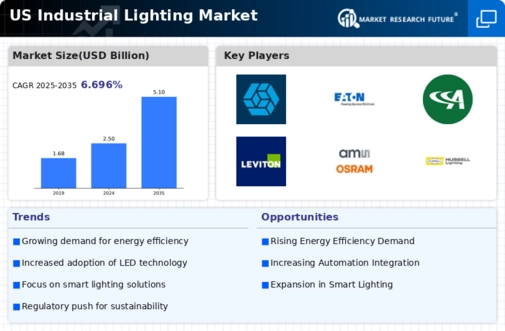Focus on Workplace Safety
Workplace safety remains a paramount concern for industries across the board, and adequate lighting is a critical component of a safe working environment. The industrial lighting market is influenced by the increasing emphasis on safety protocols, which necessitate well-lit spaces to prevent accidents and enhance visibility. Poor lighting can lead to workplace injuries, thereby prompting companies to invest in high-quality lighting solutions that meet safety standards. Moreover, the implementation of advanced lighting technologies, such as motion sensors and adaptive lighting systems, further contributes to safety by ensuring that areas are illuminated only when needed. This focus on safety not only drives demand for new lighting installations but also encourages the retrofitting of existing systems. As industries prioritize safety, the industrial lighting market is expected to see sustained growth.
Growing Demand for Automation
The increasing trend towards automation in industrial settings is significantly impacting the industrial lighting market. As industries adopt automated systems for production and management, the need for advanced lighting solutions that integrate seamlessly with these technologies becomes apparent. Automated lighting systems, which can adjust based on occupancy and natural light levels, enhance energy efficiency and operational effectiveness. This shift is particularly relevant in sectors such as manufacturing and warehousing, where lighting plays a vital role in both safety and productivity. The industrial lighting market is likely to benefit from this growing demand, as companies seek to implement smart lighting solutions that align with their automation strategies. Furthermore, the potential for reduced energy consumption and improved operational efficiency positions automated lighting as a key driver in the market.
Regulatory Compliance and Standards
Regulatory compliance plays a crucial role in shaping the industrial lighting market. Various federal and state regulations mandate specific lighting standards to ensure safety and efficiency in industrial environments. For instance, the Occupational Safety and Health Administration (OSHA) sets forth guidelines that require adequate illumination in workplaces to prevent accidents and enhance worker productivity. Compliance with these regulations often necessitates the upgrade of existing lighting systems, thereby driving demand in the industrial lighting market. Additionally, adherence to energy efficiency standards, such as those outlined by the Department of Energy (DOE), compels industries to transition to more efficient lighting solutions. This regulatory landscape not only influences purchasing decisions but also encourages innovation within the market, as manufacturers strive to develop products that meet or exceed these standards.
Technological Advancements in Lighting
The industrial lighting market is experiencing a surge in technological advancements, particularly with the integration of LED technology. This shift is driven by the need for energy-efficient solutions that reduce operational costs. LEDs consume up to 75% less energy than traditional lighting options, which is a compelling factor for industries aiming to lower their energy bills. Furthermore, the lifespan of LED fixtures, often exceeding 50,000 hours, minimizes maintenance costs and downtime. As industries increasingly adopt smart lighting systems, the industrial lighting market is likely to see a significant transformation. The incorporation of sensors and automation not only enhances energy efficiency but also improves workplace safety and productivity. This trend indicates a robust growth trajectory for the industrial lighting market, as companies invest in modern lighting solutions to meet both regulatory standards and operational demands.
Economic Growth and Industrial Expansion
The industrial lighting market is poised for growth, driven by the broader economic expansion in the United States. As industries recover and expand, there is an increasing need for efficient and effective lighting solutions. The manufacturing sector, in particular, is witnessing a resurgence, with investments in new facilities and upgrades to existing infrastructure. This expansion creates opportunities for the industrial lighting market, as companies seek to enhance their operational capabilities through improved lighting systems. Additionally, the growth of e-commerce and logistics sectors necessitates advanced lighting solutions in warehouses and distribution centers. The projected increase in industrial output and the corresponding demand for lighting solutions suggest a favorable outlook for the industrial lighting market, as businesses prioritize investments in infrastructure to support their growth strategies.






















Leave a Comment